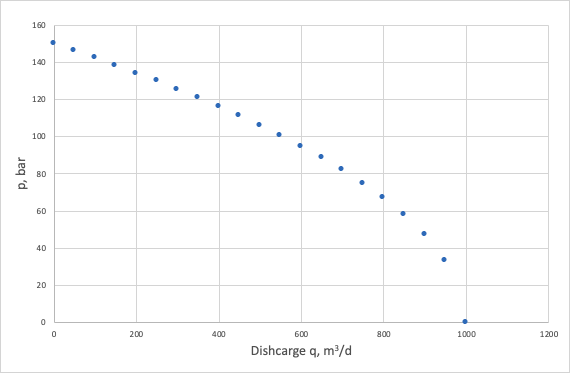...
| LaTeX Math Block |
|---|
| anchor | pump_m |
|---|
| alignment | left |
|---|
|
\dot m = M(p_{\rm out}, p_{\rm in}) |
It's often presented in terms of intake volumetric flowrate:
| LaTeX Math Block |
|---|
| anchor | Y440Npump_q |
|---|
| alignment | left |
|---|
|
q = q_{in} = \frac{\dot m}{\rho(p_{in})} = \frac{M(p_{\rm out}, p_{\rm in})}{\rho(p_{in})} |
...
In most practical cases the pump model
| LaTeX Math Block Reference |
|---|
|
depends on the difference between intake and discharge pressure | LaTeX Math Inline |
|---|
| body | --uriencoded--p_%7B\rm out%7D - p_%7B\rm in%7D |
|---|
|
and called Pump Characteristic Curve (see Fig. 1):| LaTeX Math Block |
|---|
|
q = q(p_{\rm out} - p_{\rm in}) |
A popular popular pump proxy model is given by the quadratic equation with 3 inputs (| LaTeX Math Inline |
|---|
| body | --uriencoded--\%7B q_%7B'rf max%7D, \delta p_%7B\rm max%7D, k_f \%7D |
|---|
|
):
| LaTeX Math Block |
|---|
| anchor | q_pump |
|---|
| alignment | left |
|---|
| q = \frac{q_{\rm max}}{2 \cdot k_f} \cdot \left[ -1 + k_f + \sqrt{ (1 + k_f)^2 - 4 \cdot k_f \cdot (p_{\rm out}- p_{\rm in})/\delta p_{\rm max}) \ } \, \right] |
| | LaTeX Math Block |
|---|
| anchor | q_pump |
|---|
| alignment | left |
|---|
| p_{\rm out} = p_{\rm in} + \delta p_{\rm max} \cdot \left[ 1+
(k_f -1 ) \cdot \frac{q}{q_{\rm max}} - k_f \cdot \left( \frac{q}{q_{\rm max}} \right)^2
\right ] |
|
| LaTeX Math Block |
|---|
|
\eta(q) = 4 \, \eta_{\rm max} \cdot q/q_{\rm max} \cdot ( 1 - q/q_{\rm max}) |
where
| LaTeX Math Inline |
|---|
| body | --uriencoded--\delta p_%7B\rm max%7D |
|---|
|
| maximum pressure gain that pump can exert over the input pressure |
|---|
| maximum flowrate that pump can produce |
|---|
| total hydraulic pump friction (dimensionless) |
|---|
| pump efficiency efficiency |
|---|
| maximum pump efficiency |
|---|
Real pumps have non-constant friction coefficient which often modelled as a 3rd order polynomial and the overall real-pump model taking 6-inputs.
Many The plunger pump and centrifugal pumps can be normally adjusted by the variation of the working frequency frequency which affects the maximum the maximum pump flowrate and maximum pressure gain as:
| LaTeX Math Block |
|---|
| q_{\rm max} = q^*_{\rm max} \cdot \frac{f}{f^*} |
| | LaTeX Math Block |
|---|
| \delta p_{\rm max} = \delta p^*_{\rm max} \cdot \left( \frac{f}{f^*} \right)^2 |
|
where
| LaTeX Math Inline |
|---|
| body | --uriencoded--q_%7B\rm max%7D |
|---|
|
| maximum intake flowrate at the working frequency | | LaTeX Math Inline |
|---|
| body | --uriencoded--\delta p_%7B\rm max%7D |
|---|
|
| maximum pressure gain at the working frequency | | adjusted working frequency |
| LaTeX Math Inline |
|---|
| body | --uriencoded--q%5e*_%7B\rm max%7D |
|---|
|
| maximum intake flowrate at the nominal frequency | | LaTeX Math Inline |
|---|
| body | --uriencoded--\delta p%5e*_%7B\rm max%7D |
|---|
|
| maximum pressure gain at the nominal frequency | | nominal frequency |
See also
...
Natural Science / Engineering / Device / Pump
...
